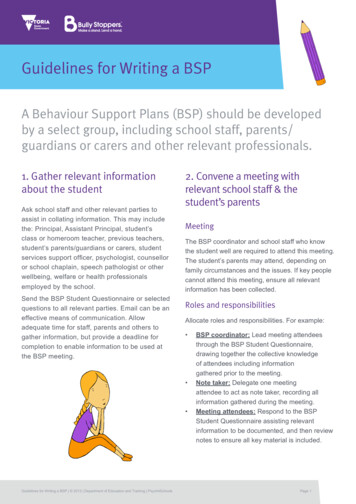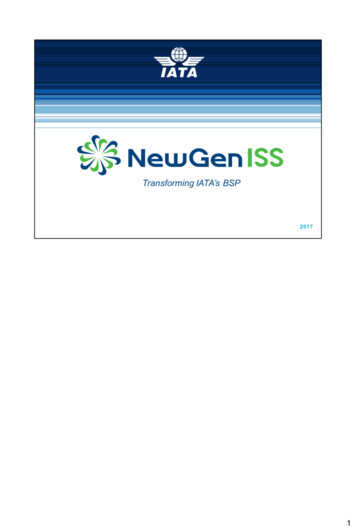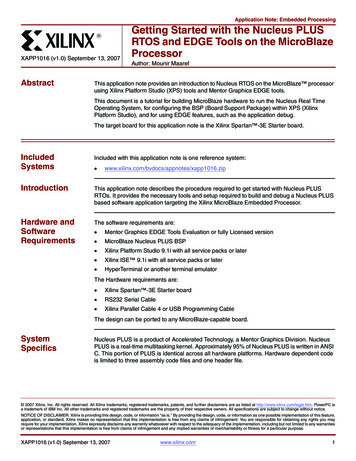
Transcription
Guidelines for Writing a BSPGuidelines for Writing a BSPA Behaviour Support Plans (BSP) should be developedby a select group, including school staff, parents/guardians or carers and other relevant professionals.1. Gather relevant informationabout the studentAsk school staff and other relevant parties toassist in collating information. This may includethe: Principal, Assistant Principal, student’sclass or homeroom teacher, previous teachers,student’s parents/guardians or carers, studentservices support officer, psychologist, counselloror school chaplain, speech pathologist or otherwellbeing, welfare or health professionalsemployed by the school.Send the BSP Student Questionnaire or selectedquestions to all relevant parties. Email can be aneffective means of communication. Allowadequate time for staff, parents and others togather information, but provide a deadline forcompletion to enable information to be used atthe BSP meeting.2. Convene a meeting withrelevant school staff & thestudent’s parentsMeetingThe BSP coordinator and school staff who knowthe student well are required to attend this meeting.The student’s parents may attend, depending onfamily circumstances and the issues. If key peoplecannot attend this meeting, ensure all relevantinformation has been collected.Roles and responsibilitiesAllocate roles and responsibilities. For example: Guidelines for Writing a BSP 2013 Department of Education and Training Psych4SchoolsBSP coordinator: Lead meeting attendeesthrough the BSP Student Questionnaire,drawing together the collective knowledgeof attendees including informationgathered prior to the meeting.Note taker: Delegate one meetingattendee to act as note taker, recording allinformation gathered during the meeting.Meeting attendees: Respond to the BSPStudent Questionnaire assisting relevantinformation to be documented, and then reviewnotes to ensure all key material is included.Page 1
Guidelines for Writing a BSPQuestionsPresent all relevant information known aboutthe student at this meeting. School staff need tobe mindful of privacy issues for the student andfamily. Ask: What information, if any, is missing? Who is going to follow up on missinginformation? Can the plan be drafted at the nextmeeting? When can we next meet, as a group, todraft the BSP? Who will attend?3. Convene a meeting of relevantschool staff to draft the BSPMeetingThe BSP coordinator and relevant school staffare required to attend this meeting. If all partiesare not able to be present at this meeting thenensure their input is included.Roles and responsibilities BSP coordinator: Leads the group in draftingthe BSP on the BSP template, drawing uponinformation gathered at the previous meeting.Meeting attendees: assist thecoordinator to draft the BSP.HintA data projector may be useful to enable allattendees to see what is being documented.ReviewReview all collected information to identify keyareas of need, in order to prepare an effective BSP.Please Note:This graphic indicates information that needs to be written into the BSB plan. Wesuggest you refer to these guidelines when completing the BSP.Guidelines for Writing a BSP 2013 Department of Education and Training Psych4SchoolsPage 2
Guidelines for Writing a BSPPertinent background informationKeep information in this section to a minimum. Only list information that school staffneed to know to assist with implementing the plan.For most students this section may be blank, or include only a diagnosis, orsignificant life event that is impacting on the student.Do not list all background information, or information of a sensitive or confidentialnature.Be mindful that whilst parents know that their child has some difficulties it can bedistressing to see this in print and parents must receive a copy of this BSP.Behaviours in need of supporta. Target behavioursReview the problem behaviours. Ensure each attendee has the same understandingof the behaviours. Write a description if necessary.Rank the behaviours. Physical violence, threats of violence, bullying and discrimination should be the top priority, followed by inappropriate behaviours that occurfrequently, through to support behaviours for students with wellbeing needs. It canbe helpful to develop a baseline of the frequency of each behaviour to establishwhether it is an actual or a perceived issue. This is achieved through record keeping orobservation of the student for set periods of times.Identify those behaviours that will be the target, or focus, for this BSP. One to threeis best, and no more than five. Other behaviours can be included when the initial targetbehaviours are resolved, and an updated BSP may then need to be created.Wording is important. Ensure listed target behaviours are specific and measureable.Write the behaviour you would like to see, where possible. For example,‘Keep hands and feet to self’ rather than ‘No hitting or kicking’.Use positive language. For example, ‘stop verbal aggression’ could be‘Promote pro-social speech by helping the student to reduce swearing,yelling and use of ‘put downs’ with peers and younger students’.Guidelines for Writing a BSP 2013 Department of Education and Training Psych4SchoolsPage 3
Guidelines for Writing a BSPb. Known warning signs of impending behaviourReview information from the BSP Student Questionnaire. Identify warning signs.List warning signs. Aim to document conditions or situations that may lead to theproblem behaviour, to help teachers intervene before the unwanted behaviour occurs.If warning signs are unknown or unpredictable add them to the BSP as they aredetected.c. Known triggers of impending behaviourReview information from the BSP Student Questionnaire. Identify triggers.List triggers. Aim to document conditions or situations that may lead to the problembehaviour, to help teachers to remove these triggers before the unwanted behaviouroccurs.If triggers are unknown or unpredictable add them to the BSP as they aredetected.d. Preventative strategies and techniquesReview BSP Student Questionnaire. List techniques that can be implementedimmediately. For example: Move close to the student, and quietly remind them what they should be doing.Keep talk to a minimum, support communication with hand gestures and pointing.Use the student’s name and calmly redirect the student, rather than reprimand.Help the student refocus on the work ‘(Student’s name) I’ll help you get started.’Identify a learning strength the student has and link the strength to the task.Set a working agreement with the student, which may include a choice.Maintain respect and a liking for the student but foreshadowa warning for the problem behaviour.Remind the class of the relevant classroom or playground rule.Use consequences aimed to resolve the problem or restore the harm.Signal the implementation of down time. Ask the student tomove to a calm and safe space, or to take a note to anotherteacher asking them to provide 10 minutes of quiet time.Guidelines for Writing a BSP 2013 Department of Education and Training Psych4SchoolsPage 4
Guidelines for Writing a BSPProactive strategies and techniquesIdentify situations and/or environments that relate specifically to the student’sbehaviour. Only fill in content for relevant situations and ignore irrelevant ones.Consider possible problem situations and environments, such as when CRTs arepresent, environments where supervision may be reduced, or in secondary schools,when movement between classes takes place or when the student goes to the toilet.For example, the student may have no issues at break times but need specificsupervision or modifications during physical education lessons. Therefore, physicaleducation sessions would be included in this column, but not recess and lunch.a. Target behavioursList target behaviours with their situations or environments, as described.b. StrategiesThink about the cause of the behaviour/s to help in developing effective strategies. Ask: What may be causing the behaviour/s? These may be identified in Step 1 and 2of the BSP Student Questionnaire. The ‘cause’ may need to be carefully reviewedwith the student support services officer, parents, or the wellbeing, welfare or healthprofessional involved.What can we do about it? Tailor strategiesto suit the student’s individual needs.Focus on reducing the cause of theproblem. Both short term and long termsolutions should be included. Consider therole a parent or carer might provide.Guidelines for Writing a BSP 2013 Department of Education and Training Psych4SchoolsPage 5
Guidelines for Writing a BSPEnsure the listed strategies are holistic and achievable for the student. Consider: Research wellbeing information. Visit the DEECD website, the free resourcessection of the Psych4Schools website at www.psych4schools.com.au,review information held at school and knowledge gained from experience.Allow down time or calming options.Ensure appropriate academic interventions, allowances and modifications arebeing implemented. For example, for students who are slow learners, teacherquestions might focus more on knowledge and remembering.Whereas for more able students, allowing them to formulatequestions can help to create deeper and richer understandings.Ensure allowances are made for appropriate supervision of the student. Forexample, at recess and lunchtime a ground plan may be needed to set limitationson play or activity areas and who the student plays or associates with and when.What might be one thing that can reduce ‘pressure’ or conflict, or helpthe student feel more connected at home or if living between homes,with all adults? What help and assistance can be provided?Think about how the strategies are worded. Strategies or interventions must be specific. Rather than writing‘social skills group’, write ‘Attend Ms. Low’s Term 3 social skillsgroup focusing on turning taking, and playing by the rules.’c. Beginning date—Concluding dateWhat is the intervention timeline? How long will the strategy be in place? When will itbegin and end? This helps when reviewing and modifying the BSP. It also helps schoolstaff and the student know that the plan is not open-ended, that real change, throughappropriate support, is expected. Many interventions are based on a five to ten weektime frame. The maximum intervention may occur over several years, but term-by-termreviews help indicate that real change is expected. When real change occurs it shouldbe celebrated or acknowledged.d. Who is responsible for implementation?The BSP coordinator, relevant staff members and other persons will help implementand monitor the strategy. Be specific and use staff members’ names, rather than theiryear level or subject area.Guidelines for Writing a BSP 2013 Department of Education and Training Psych4SchoolsPage 6
Guidelines for Writing a BSPGood behaviour recognitiona. What works to promote good behaviour for this student?Examples may include: Provide immediate positive feedback. (sticker, stamp, house points, praise)Implement outcomes from a rewards chart.Grant extra time at a favoured activity. (computer, gardening)Acknowledge pro-social behaviour at assembly or class meetings.Reward systems and praise don’t work for all students, especially those who arevery defiant. The following can work well: Show the student you like and respect them, but not their behaviour.Foreshadow warnings and privileges, and give some control to the student.Use labelled encouragement. This describes the behaviour you areseeing ‘I like the way you have started on your own’ delivered in aneutral voice, and is said to the student quietly and privately.Offer a responsibility for on-going co-operative behaviour.b. How will we know if the recognition is successful?There needs to be a system such as an electronic diary to record or graph behaviour.c. Who is responsible for providing good behaviour recognition?Be specific and use staff members’ names, rather than their year level or subject area.d. When and how often is behaviour recorded?For example, the Year Level Coordinator, Mrs. Barnes will record entries twice a day at11am and 3.20pm.Guidelines for Writing a BSP 2013 Department of Education and Training Psych4SchoolsPage 7
Guidelines for Writing a BSPConsequencesa. List consequencesIdentify what will happen if the student does not follow the rules or continues to displaychallenging behaviour. This may be a series of statements or a step-by-step list.For example, the series of statements could be: Regular student discipline procedures will be followed. (This mayinclude additional steps for this particular student, but will includeadditional steps for all students with disabilities or disorders).Address problem behaviour directly and immediately. Use the student’sname, name what they are doing wrong, and ask them to stop.Continue to ensure all consequences aim to resolvethe problem or restore the harm.Use restorative practice techniques.The step-by-step approach could be:1. Regular classroom discipline warning system.2. If the student does not stop the behaviour, call a ‘buddy’ teacher or a seniorstaff member. The student may be asked to leave the classroom.3. If the student refuses to leave, the class teacher will remove the class. The ‘Buddy’teacher or senior staff member will stay with the student in the classroom.4. Student conference with Year Level Coordinator, Assistant Principal or Principal.5. Call student’s parents to inform of behaviour.6. Set a short-term verbal agreement for appropriate behaviourover the next day or two and/or until you meet again.b. Who is responsible for giving consequences?Be specific and use staff members’ names, rather than their year level or subject area.c. When and how often are statements or approaches recorded?For example, the Year Level Coordinator, Mrs. Barnes will record entries twice a day at11am and 3.20pm.Guidelines for Writing a BSP 2013 Department of Education and Training Psych4SchoolsPage 8
Guidelines for Writing a BSPCrisis plana. BehavioursList observable behaviours or circumstances that would lead to the crisis plan beingenacted. For example, if the following behaviours are observed: Physical threatHighly agitated—such as raised voice, making afist, clenching and unclenching handsViolent or threatens violence.b. ActionsList the steps you will take when the student is ‘at risk’ of harm or harming others, orwhen a major incident occurs, such as, serious threats, actual violence, or when thestudent is out-of-control.Consider whether mandatory and/or legal requirements need to be followed? Doagencies need to be contacted to support the student?In extreme emergencies police and/or ambulance support should be included in thisplan. For example: Call for assistance from Assistant Principal, Principal or senior staff member.Separate student from other students—either by removing thestudent, or if this is not possible removing the other students.Call parents to collect student. If unable to contact them, callothers on contact list according to specified order.Call 000 if necessary.Log incident with the DEECD emergency management, phone (03) 9589-6266.Guidelines for Writing a BSP 2013 Department of Education and Training Psych4SchoolsPage 9
Guidelines for Writing a BSPc. Who is responsible?List who is responsible for each step above. Be specific and use staff members’names, rather than their year level or subject area. For example:1. Class teacher: Mr John Smith2. Class teacher or Assistant Principal/Principal: Mr John Smith, Ms Kathy Locke, MrsSimone Black3. Principal/Office Manager: Mrs Simone Black, Ms Joyce Hunt4. Principal/Assistant Principal: Mrs Simone Black, Ms Kathy Locke,5. Principal: Mrs Simone BlackStudent’s preferred school staff contactsList staff members the student trusts, likes and works with most frequently.One or two of these staff members may be able to help restore calm if nothing seems tobe working or the situation is in crisis. Safety of all concerned is a priority at all times.Reviewa. Review dateWrite the date and time of the BSP review meeting.b. Who is involved?List staff members involved in the review process. The parents and student may beincluded.c. How is it monitored?Monitoring options include: teacher observation, student self-reflection, a behaviourdiary and/or chart, term achievement list and Student Support Group meetings led bythe BSP Coordinator. A combination of monitoring ideas will often be most effective.Actions that require the student to reflect on or self report positive achievements willoften help.Guidelines for Writing a BSP 2013 Department of Education and Training Psych4SchoolsPage 10
Guidelines for Writing a BSP4. Refine the BSP7. Review the BSPHave relevant staff members, parents, otherschool professionals and if possible the studentprovide feedback on the plan, before it isfinalised and signed off.MeetingHave key staff members agree to and sign theplan—including the Principal.Those responsible for monitoring the student’sbehaviour and the effectiveness of the planshould attend the review meeting. If all partiescannot be present at this meeting, those presentreview the plan based on information gatheredfrom the missing parties. If this is the case, thereviewed plan should be shared with all partiesbefore it is finalised.Have the parent, and student agree to and signthe plan.Roles and responsibilities6. Provide a copy to staffThe BSP Coordinator is responsible forreviewing the BSB.Modify as required.5. Sign the BSPDistribute to all staff who have contact with thestudent.Confidentiality is paramount. Ensure that all staffstore the plan securely.Talk staff through the plan, ideally at a staff ordepartment meeting.Create a copy of the plan for the casual reliefteacher (CRT) or the emergency teacher file.Why review the BSP?Regular reviews will ensure the BSP staysrelevant. Reviews ensure appropriate behavioursare being targeted, and effective strategies andinterventions implemented to support the studentin changing their behaviour. New information canalso be added.When should the BSP be reviewed?Trial the plan for a week or two before fullimplementation. Depending on the student or theplan, the plan may need to be revised every twoto four weeks and/or at least once a term.Guidelines for Writing a BSP 2013 Department of Education and Training Psych4SchoolsPage 11
Guidelines for Writing a BSPEmergency reviews8. Concluding the BSPEmergency reviews, prior to the set review date,may need to occur in the following circumstances:Roles and responsibilities On professional advice (suchas a doctor, psychologist)Significant change in thestudent’s circumstancesChallenging behaviour is escalatingAdditional challenging behaviour occursThe student is at risk of expulsion.ConsiderationsWhen reviewing the plan consider: Is it working? If not, why?Are all staff following the plan?Do we need to update rewards?Were our expectations for the student’sbehaviour initially too high (doesthe bar need to be set lower)?Do the strategies match the student’s needs?Has an important factor or stepbeen left off the plan?Has something changed? Timetable,staff member availability, familycircumstances and so on.Is information missing? Who willcollect this information?Rewrite or fine-tune the plan,then follow steps 5-7.Guidelines for Writing a BSP 2013 Department of Education and Training Psych4SchoolsThe Principal or Assistant Principal can sign offon the plan’s completion.GoalsThe BSP aims to help ensure that studentsfeel safe, valued and connected to their schoolcommunity. General observation that harmonyhas been restored or diminished is a goodindicator that the plan is achieving its goals.ConclusionThe BSP can be concluded when significantpositive change has been demonstrated overfour weeks or more, without incident, throughimproved behaviour and wellbeing, and newlearning is being demonstrated.At this stage the plan can be concluded and thestudent monitored for the following term.Page 12
Guidelines for Writing a BSP 2013 Department of Education and Training Psych4Schools. Guidelines for Writing a BSP. Page 2. Questions. Present all relevant information known about










